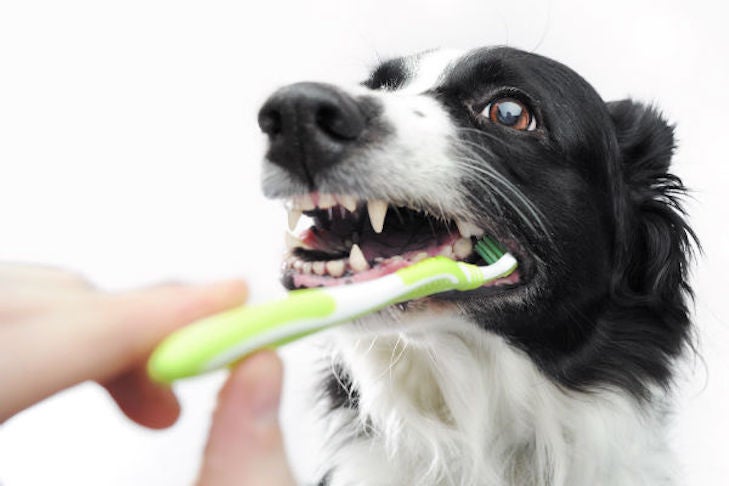
February is National Pet Dental Health Month, made to raise awareness of the importance of maintaining your pet’s dental hygiene. Unfortunately, despite what some people believe, domestic dogs don’t automatically instinctively take care of their teeth by chewing.
Like humans, dogs can suffer periodontal disease, tooth decay, injured teeth and other oral health problems. Beyond discomfort and bad breath, these dental problems can lead to serious health issues including kidney disease, heart disease and more as well as costly dental care.
Over the years as both a private practice veterinarian and dog owner, I’ve learned that when it comes to dental hygiene, taking preventative steps at home along with regular office visits are well worth the effort, not only for your pet’s overall health and comfort, but for your budget as well. Canine teeth cleaning or periodontal care performed by a veterinarian is a costly medical treatment and requires that your dog be sedated with anesthesia. Though a periodic thorough veterinary dental cleaning may be eventually needed, why not try to minimize the need if you can?
How Can I Tell if My Dog Has Bad Dental Health?
Every dog should have a thorough oral examination by a veterinarian to assess the integrity and health of the teeth, gums, tongue and other oral structures. This exam should be a part of each yearly exam. Signs of oral disease include:
- Foul or fetid smell to the mouth, this includes saliva
- Inflamed gums
- Bloody mouth, gums or gum line, or bloody saliva
- Difficulty chewing
It’s unreasonable to expect a dog’s breath to be “minty fresh”, but it should be at least neutral. Foul breath could be a sign that there is something occurring in the mouth and requires a visit to the veterinarian. However, do not rely solely on your dog’s breath to keep tabs on dental hygiene and make sure to maintain a regular veterinary checkup schedule.
What Should I Look For When I Look in My Dog’s Mouth?
Plaque – The first buildup of material growing on the enamel of the tooth within hours of your dog eating. Plaque combines with dog saliva, builds up and hardens, resulting in damage causing tartar. This may not be overtly evident on cursory exam.
Tartar – A build up of plaque, it is comprised of various organic materials such as bacteria, serum, food particles and mineral salts. In the early stages, tartar begins as soft matter on the tooth enamel, but will build-up and harden as time passes. Tartar build up can cause gum inflammation and disease, tooth decay, abscesses and other oral infections impacting a dog’s overall health.
Can different sized dogs have different teeth problems?
Smaller breeds such as toy breed dogs may have an increased risk for tartar formation, gum recession, and eventual loss of teeth. Whereas large breed dogs in addition to dental tartar build-up, are also at a higher risk for tooth fracturing due to aggressive chewing. Such fractures can lead to decay, infection, tooth loss and disease.
What Can You Do At Home?
Brushing and Toothpastes
From disposable dental wipes to dog-friendly flavored toothpaste, a variety of pet-safe dental care products exist in the marketplace. Ask your vet what’s best for your dog and know that some trial and error may be required depending your dog’s breed and temperament.
- Dental wipes are intended for daily use to remove plaque.
- Dog toothbrushes come in all sizes and in general are soft and angled to easily reach the back teeth. Some dog owners prefer “finger brushes” which are soft silicone brushes you insert for finger into for brushing.
- NEVER use toothpaste intended for humans. ONLY use veterinarian-approved toothpaste for dogs. Check the ingredient list to ensure there is no xylitol. Xylitol is potentially fatal to dogs.
A Guide to Brushing Your Dog’s Teeth:
Start early. Typically, after adult teeth have erupted, around 6 months of age. Apply a small amount of canine toothpaste to either your finger or a dog toothbrush or finger brush and let him taste it. Get your dog accustomed to the various types of brushing, from touching and opening the lips, to lightly touching the teeth with your finger to finger-brush. These steps could take days or weeks. It’s important to be patient with your dog.
Have a regular schedule of brushing, with a goal of once a day, but 3-4 times per week would be considered fine by most veterinarians. Working on the outside of the upper middle and upper teeth, work outwards to each side. Repeat on the bottom teeth. Make sure to get as far back as possible on all sides holding the brush at a 45-degree angle.
Additional Treatments: Diet & Chews
There are plenty of diets and chew toys and products on the market advertised to help with canine oral health.
Feeding your dog a well-balanced diet in accordance with veterinary guidelines for age and breed is an important step in oral health.
Dog chews are not only created for play and preventing destructive behavior, some are intended for the sole purpose of dental health. Be cautious and informed before purchasing, not all chews are created equal. Many are too hard and can cause dental fractures or pose choking hazards.
While February is National Pet Dental Health Month, dental health should be a daily ritual for pet owners all year long. When it comes to the oral health of your dog, awareness and prevention are in order. Your veterinarian and The American Kennel Club are here to help keep both you and dog your smiling!

